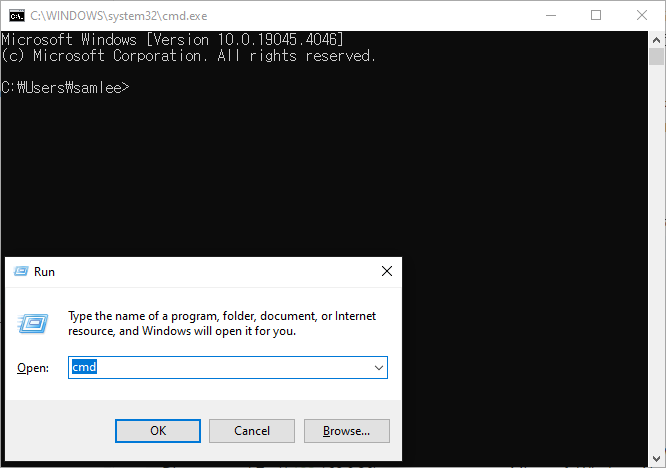Problema de tiempo de carga prolongado al abrir Windows Mi PC
Cuando abres Esta PC de Windows, el problema del tiempo de carga prolongado puede deberse a varias razones. Sin embargo, si ha registrado una carpeta compartida de red como unidad y la unidad de red registrada es actualmente inaccesible, esto puede ser la causa del problema de que las unidades tarden mucho en aparecer en su PC.
Por supuesto, puede desconectar y eliminar la unidad de red inaccesible a través del menú contextual, pero con tiempos de carga prolongados, incluso este método puede no ser posible. Entonces, aunque es un poco complicado, presentaré cómo eliminar una unidad de red usando un comando en el símbolo del sistema de Windows.
Abrir una ventana del símbolo del sistema
Presione la tecla de acceso directo “Windows + R” para abrir la ventana “Ejecutar”. Luego escriba cmd para abrir el símbolo del sistema.
 Ejecute el acceso directo
Ejecute el acceso directo Windows + R > Ingrese cmd > Aceptar
Ver y eliminar unidades de red
Ingrese el comando net use en el símbolo del sistema. Al ingresar esto, puede verificar el estado de la unidad de red registrada. En mi caso, la unidad Z se muestra como “Desconectada” y sospecho que esta es la causa del problema de carga prolongada en mi PC.
1
2
3
4
5
6
7
8
9
10
11
C:\Windows\System32>net use
New connections will be remembered.
Status Local Remote Network
-------------------------------------------------------------------------------
OK R: \\pcname.ad.company.com\Data Microsoft Windows Network
Disconnected Z: \\192.168.0.20\username Microsoft Windows Network
The command completed successfully.
Una vez que haya confirmado la letra de la unidad que desea eliminar, puede eliminar la unidad de red con el siguiente comando.
- uso neto /eliminar <letra de unidad:>
1
2
3
C:\Windows\System32>net use /delete Z:
Z: was deleted successfully.
En mi caso, después de eliminar la unidad Z, el problema de carga prolongada en mi PC ya no volvió a ocurrir.
Apéndice
A continuación se detallan las opciones disponibles con el comando net use mencionado anteriormente.
1
2
3
4
5
6
7
8
9
10
11
12
13
14
15
16
17
18
19
20
21
22
23
24
25
26
27
28
29
30
31
32
33
34
35
36
37
38
39
40
41
42
43
44
45
46
47
48
49
50
51
52
53
54
55
56
57
58
59
60
61
62
63
64
65
66
67
68
69
70
71
72
C:\Windows\System32>net use /h
The syntax of this command is:
NET USE
[devicename | *] [\\computername\sharename[\volume] [password | *]]
[/USER:[domainname\]username]
[/USER:[dotted domain name\]username]
[/USER:[username@dotted domain name]
[/SMARTCARD]
[/SAVECRED]
[/REQUIREINTEGRITY]
[/REQUIREPRIVACY]
[/WRITETHROUGH]
[[/DELETE] | [/PERSISTENT:{YES | NO}]]
NET USE {devicename | *} [password | *] /HOME
NET USE [/PERSISTENT:{YES | NO}]
NET USE connects a computer to a shared resource or disconnects a
computer from a shared resource. When used without options, it lists
the computer's connections.
devicename Assigns a name to connect to the resource or specifies
the device to be disconnected. There are two kinds of
devicenames: disk drives (D: through Z:) and printers
(LPT1: through LPT3:). Type an asterisk instead of a
specific devicename to assign the next available
devicename.
\\computername Is the name of the computer controlling the shared
resource. If the computername contains blank characters,
enclose the double backslash (\\) and the computername
in quotation marks (" "). The computername may be from
1 to 15 characters long.
\sharename Is the network name of the shared resource.
\volume Specifies a NetWare volume on the server. You must have
Client Services for Netware (Windows Workstations)
or Gateway Service for Netware (Windows Server)
installed and running to connect to NetWare servers.
password Is the password needed to access the shared resource.
* Produces a prompt for the password. The password is
not displayed when you type it at the password prompt.
/USER Specifies a different username with which the connection
is made.
domainname Specifies another domain. If domain is omitted,
the current logged on domain is used.
username Specifies the username with which to logon.
/SMARTCARD Specifies that the connection is to use credentials on
a smart card.
/SAVECRED Specifies that the username and password are to be saved.
This switch is ignored unless the command prompts for username
and password.
/HOME Connects a user to their home directory.
/DELETE Cancels a network connection and removes the connection
from the list of persistent connections.
/REQUIREINTEGRITY
Requires a signed connection to the share. The operation will fail
if the provider does not support signed connections.
/REQUIREPRIVACY Requires an encrypted connection to the share. The operation will fail
if the provider does not support encrypted connections.
/PERSISTENT Controls the use of persistent network connections.
The default is the setting used last.
YES Saves connections as they are made, and restores
them at next logon.
NO Does not save the connection being made or subsequent
connections; existing connections will be restored at
next logon. Use the /DELETE switch to remove
persistent connections.
NET HELP command | MORE displays Help one screen at a time.
